
Vänern is the largest lake in Sweden, the largest lake in the European Union and the third-largest lake in Europe after Ladoga and Onega in Russia. It is located in the provinces of Västergötland, Dalsland, and Värmland in the southwest of the country. With its surface located at 44 metres (144 ft) above sea level and a maximum depth of 106 metres (348 ft), the lowest point of the Vänern basin is 62 metres (203 ft) below sea level. The average depth is a more modest 28 metres (92 ft), which means that the lake floor is above sea level on average.

In Norse mythology, Gylfi, Gylfe, Gylvi, or Gylve was the earliest recorded king of Sviþjoð, Sweden, in Scandinavia. He is known by the name Gangleri when appearing in disguise. The Danish tradition on Gylfi deal with how he was tricked by Gefjon and her sons from Jötunheim, who were able to shapeshift into tremendous oxen.

Ynglinga saga is a Kings' saga, originally written in Old Norse by the Icelandic poet and historian Snorri Sturluson about 1225. It is the first section of his Heimskringla. It was first translated into English and published in 1844 by Samuel Laing.
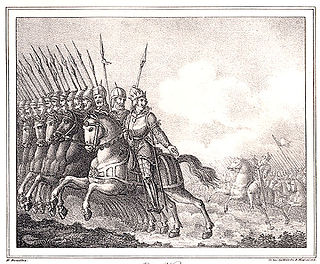
Eadgils, Adils, Aðils, Adillus, Aðísl at Uppsölum, Athisl, Athislus or Adhel was a semi-legendary king of Sweden, who is estimated to have lived during the 6th century.
Onela was, according to Beowulf, a Swedish king, the son of Ongentheow and the brother of Ohthere. He usurped the Swedish throne, but was killed by his nephew Eadgils, who won by hiring foreign assistance.

Jorund or Jörundr was a Swedish king of the House of Yngling. He was the son of Yngvi, and he had reclaimed the throne of Sweden for his dynasty from Haki.
In Norse mythology, Dyggvi or Dyggve was a Swedish king of the House of Ynglings. Dyggvi died and became the concubine of Hel, Loki's daughter. Dyggvi was succeeded by his son Dag the Wise. According to Snorri Sturluson, Dyggvi was the nephew of Dan, the eponymous ancestor of Denmark, through his sister Drott, and was the first to be called King by his family.
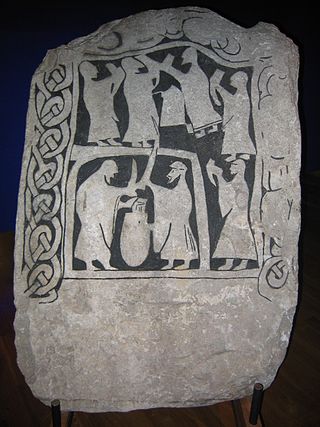
In Norse mythology, the Swedish king Domar of the House of Ynglings was the son of Domalde. He was married to Drott, the sister of Dan the Arrogant who gave his names to the Danes. Drott and Dan are in this work said to be the children of Danp son of Ríg.
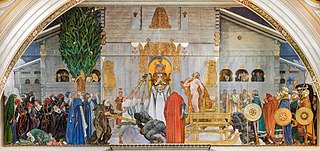
Domalde, Dómaldi or Dómaldr was a legendary Swedish king of the House of Ynglings, cursed by his stepmother, according to Snorri Sturluson, with ósgæssa, "ill-luck". He was the son of Visbur.
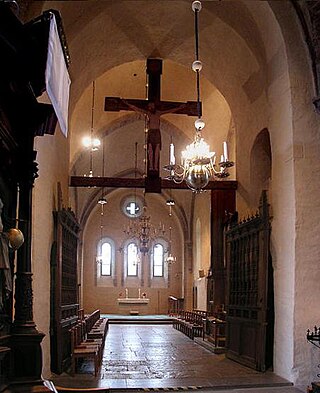
Stenkil was a King of Sweden who ruled c. 1060 until 1066. He succeeded Emund the Old and became the first king from the House of Stenkil. He is praised as a devout Christian, but with an accommodating stance towards the old Pagan religion. His brief reign saw an armed conflict with Norway.
The Battle on the Ice of Lake Vänern was a 6th-century battle recorded in the Norse sagas and referred to in the Old English epic Beowulf. It has been dated to c. AD 530.

Vanløse is one of the 10 official districts of Copenhagen Municipality, Denmark. It lies on the western border of the municipality. Vanløse covers an area of 6.69 km2, and has a population of 36,115, making Vanløse the smallest district of Copenhagen, by population.

Agnafit or Agnefit was the name of a location where Lake Mälaren met the Baltic Sea. In the 14th century, an addition to the Historia Norwegiae described Agnafit as being where Stockholm had been founded. Some say that it was a fishing village located on the island Stadsholmen, before Stockholm was founded in 1252.
Guðröðr was a legendary Scanian king who, according to the Ynglinga saga, was the brother of Halfdan the Valiant, Ivar Vidfamne's father. He is only known from late Icelandic sources dating from the 13th century.

Langelinie is a pier, promenade and park in central Copenhagen, Denmark, and home of The Little Mermaid statue. The area has for centuries been a popular destination for excursions and strolls in Copenhagen. Most cruise ships arriving in Copenhagen also berth at Langelinie Pier.

In Norse mythology, Gefjon is a goddess associated with ploughing, the Danish island of Zealand, the legendary Swedish king Gylfi, the legendary Danish king Skjöldr, foreknowledge, her oxen children, and virginity. Gefjon is attested in the Poetic Edda, compiled in the 13th century from earlier traditional sources; the Prose Edda and Heimskringla, written in the 13th century by Snorri Sturluson; in the works of skalds; and appears as a gloss for various Greco-Roman goddesses in some Old Norse translations of Latin works.

Churchillparken is a public park in Copenhagen, Denmark, occupying a tract of land between Kastellet, a 17th-century fortress, and the street Esplanaden. Located on the former esplanade which used to surround Kastellet, the area has a long history as a greenspace but received its current name in 1965 to commemorate Winston Churchill and the British assistance in the liberation of Denmark during World War II.
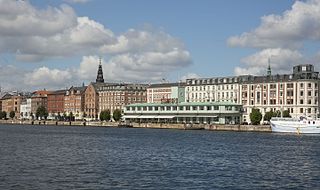
Havnegade is a waterfront promenade in central Copenhagen, Denmark, which runs along the Inner Harbour between Knippelsbro and the mouth of the Nyhavn canal. Most of the street is lined with buildings from the 1860s and 1870s that were constructed as part of the redevelopment of the Gammelholm naval dockyards. It is the only place along Copenhagen's main harbourfront where residential buildings of that age face the water, although older warehouses and other industrial buildings elsewhere have been converted into residential use. The Modernist Bank of Denmark building is located at the western end of the street.

Nordre Toldbod is a waterfront area in Copenhagen, Denmark, located at the north end of Larsens Plads and just south of Kastellet. It takes its name after the custom house or toldbod which used to be located in the area. Most of the historic buildings in the area were torn down in 1973 when the site was redeveloped but its central waterfront space has remained intact and features a number of structures which bear testament to its former use. Among the modern buildings in the area are the headquarters of Mærsk and the Danish Energy Agency. The area is adjacent to Churchill and Langelinie Parks.

Store Kongensgade is the longest street in central Copenhagen, Denmark. It extends northeast from Kongens Nytorv to Esplanaden, running parallel to Bredgade, where it breaks left, continuing northwest to Grønningen.



















